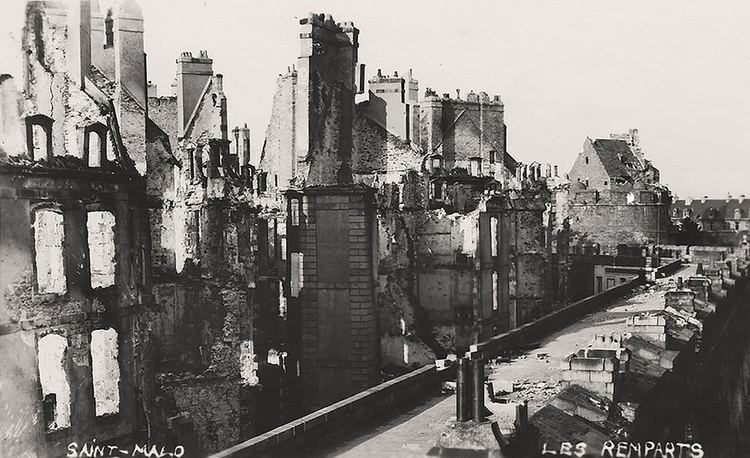Country France Region Brittany | Area 44,620 Mayor Claude Renoult | |
 | ||
Map of Saint-Malo
Saint-Malo ([sɛ̃.ma.lo]; Gallo : Saent-Malô; Breton: Sant-Maloù) is a historic walled port city and commune (with the commune expanded beyond the walls in 1968), in Brittany on the English Channel coastline of northwestern France. It is a sub-prefecture of the Ille-et-Vilaine.
Contents
- Map of Saint Malo
- Port of call saintmalo
- Lia mice saintmalo
- Population
- History
- Schools
- Higher education
- Transport
- Sites of interest
- Personalities
- Twin towns sister cities
- In popular culture
- References

Traditionally known for its independent streak, Saint-Malo was in the past notorious for privateering (the "cité corsaire"). Today the city is a major tourist destination, with many ancient structures.

Port of call saintmalo
Lia mice saintmalo
Population
The population, in 2012, was 44,620 – though this can increase to up to 200,000 in the summer tourist season. With the suburbs included, the metropolitan area's population is approximately 153,000 (2011).
The population of the commune more than doubled in 1968 with the merging of three communes: Saint-Malo, Saint-Servan (population 14,963 in 1962) and Paramé (population 8,811 in 1962).
Inhabitants of Saint-Malo are called Malouins in French. From this came the Spanish name for the Islas Malvinas, the archipelago known in English as the Falkland Islands. Islas Malvinas derives from the 1764 name Îles Malouines, given to the islands by French explorer Louis-Antoine de Bougainville. Bougainville, who founded the archipelago's first settlement, named the islands after the inhabitants of Saint-Malo, the point of departure for his ships and colonists.
History
Founded by Gauls in the 1st century B.C. The ancient town on the site of Saint-Malo was known as the Roman Reginca or Aletum. By the late 4th century AD the Saint-Servan district was the site of a major Saxon Shore promontory fort that protected the Rance river estuary from seaborne raiders from beyond the frontiers. According to the Notitia Dignitatum the fort was garrisoned by the militum Martensium under a dux (commander) of the Tractus Armoricanus and Nervicanus section of the litus Saxonicum. During the decline of the Western Roman Empire Armorica (modern day Brittany) rebelled from Roman rule under the Bagaudae and in the 5th and 6th centuries received many Celtic Britons fleeing instability across the Channel. The modern Saint-Malo traces its origins to a monastic settlement founded by Saint Aaron and Saint Brendan early in the sixth century. Its name is derived from a man said to have been a follower of Brendan the Navigator, Saint Malo or Maclou, an immigrant from what is now Wales.
Saint-Malo is the setting of Marie de France's poem "Laustic," an 11th-century love story. The city had a tradition of asserting its autonomy in dealings with the French authorities and even with the local Breton authorities. From 1590 to 1593, Saint-Malo declared itself to be an independent republic, taking the motto "not French, not Breton, but Malouin."
Saint-Malo became notorious as the home of the corsairs, French privateers and sometimes pirates. In the 19th century, this "piratical" notoriety was portrayed in Jean Richepin's play Le flibustier and in César Cui's eponymous opera. The corsairs of Saint-Malo not only forced English ships passing up the Channel to pay tribute, but also brought wealth from further afield. Jacques Cartier, who sailed the Saint Lawrence River and visited the sites of Quebec City and Montreal, and is thus credited as the discoverer of Canada, lived in and sailed from Saint-Malo, as did the first colonists to settle the Falkland Islands, hence the Islands' French name "Îles Malouines," which eventually gave rise to the Spanish name "Islas Malvinas." In 1758, the Raid on St Malo saw a British expedition land intending to capture the town. However, the British made no attempt on Saint-Malo, and instead occupied the nearby town of Saint-Servan, where they destroyed 30 privateers before departing.
In World War II, during fighting in late August and early September 1944, the historic walled city of Saint-Malo was almost totally destroyed by American shelling and bombing as well as British naval gunfire. The Allies believed that the Axis powers had thousands of troops and major armaments built up within the city walls – though there proved to be less than 100 troops manning just two anti-aircraft installations, with the much larger and heavily armed Axis presence in strongpoints outside the city walls. The Americans used napalm for the first time. Saint-Malo was rebuilt over a 12-year period from 1948–60.
The commune of Saint-Servan was merged, together with Paramé, and became the commune of Saint-Malo in 1967.
Saint-Malo was the site of an Anglo-French summit in 1998 that led to a significant agreement regarding European defence policy.
Schools
Schools include:
Higher education
Institute of Technology of Saint-Malo,
A nurse school,
A maritime school
Transport
Saint-Malo has a terminal for ferry services with daily departures to Portsmouth operated by Brittany Ferries and services on most days Poole and Weymouth in England via the Channel Islands operated by Condor Ferries. It also has a railway station, Gare de Saint-Malo, offering direct TGV service to Rennes, Paris and several regional destinations. There is a bus service provided by Keolis. The town is served by the Dinard–Pleurtuit–Saint-Malo Airport around 5 kilometres (3 miles) to the south.
Sites of interest
Now inseparably attached to the mainland, Saint-Malo is the most visited place in Brittany. Sites of interest include:
Personalities
Saint-Malo was the birthplace of:
Twin towns – sister cities
Saint-Malo is twinned with:
In popular culture
Much of the action in Anthony Doerr's 2014 award-winning novel, All the Light We Cannot See, occurs in Saint-Malo.
